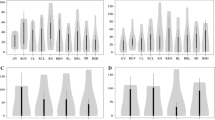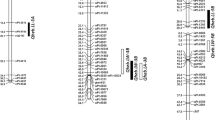Abstract
Drought stress is the major constraint to rice (Oryza sativa L.) production and yield stability in rainfed ecosystems. Identifying genomic regions contributing to drought resistance will help to develop rice cultivars suitable for rainfed regions through marker-assisted breeding. Quantitative trait loci (QTLs) linked to leaf epicuticular wax, physio-morphological and plant production traits under water stress and irrigated conditions were mapped in a doubled haploid (DH) line population from the cross CT9993-5-10-1-M/IR62266-42-6-2. The DH lines were subjected to water stress during anthesis. The DH lines showed significant variation for epicuticular wax (EW), physio-morphological and plant production traits under stress and irrigated conditions. A total of 19 QTLs were identified for the various traits under drought stress and irrigated conditions in the field, which individually explained 9.6%–65.6% of the phenotypic variation. A region EM15_10-ME8_4-R1394A-G2132 on chromosome 8 was identified for leaf EW and rate of water loss i.e., time taken to reach 70% RWC from excised leaves in rice lines subjected to drought stress. A large effect QTL (65.6%) was detected on chromosome 2 for harvest index under stress. QTLs identified for EW, rate of water loss from excised leaves and harvest index under stress in this study co-located with QTLs linked to shoot and root-related drought resistance traits in these rice lines and might be useful for rainfed rice improvement.



Similar content being viewed by others
Abbreviations
- DAS:
-
Days after sowing
- DH:
-
Doubled haploid
- EW:
-
Epicuticular wax
- MAS:
-
Marker assisted selection
- OA:
-
Osmotic adjustment
- QTLs:
-
Quantitative trait loci
- RI:
-
Recombinant inbred
- RWC:
-
Relative water content
References
Babu RC, Shashidhar HE, Lilley JM, Thanh ND, Ray JD, Sadasivam S et al (2001) Variation in root penetration ability, osmotic adjustment and dehydration tolerance among accessions of rice adapted to rainfed lowland and upland ecosystems. Plant Breed 120:233–238. doi:10.1046/j.1439-0523.2001.00578.x
Babu RC, Nguyen BD, Chamarerk V, Shanmugasundaram P, Chezhian P, Jeyaprakash P et al (2003a) Genetic analysis of drought resistance in rice by molecular markers: association between secondary traits and field performance. Crop Sci 43:1457–1469
Babu RC, Pathan MS, Shanmugasundaram P (2003b) Improving water productivity in cereal crops under rainfed ecosystem: progress in molecular genetics and genetic engineering approaches. In: Transitions in agriculture for enhancing water productivity. 23–25, September, Agricultural College and Research Institute, Killikulam, Tamil Nadu, India
Barrs HD, Weatherley PE (1962) A re-examination of the relative turgidity technique for estimating water deficits in leaves. Aust J Biol Sci 15:413–428
Bernier J, Kumar A, Venuprasad R, Spaner D, Atlin GN (2007) A large-effect QTL for grain yield under reproductive-stage drought stress in upland rice. Crop Sci 47:505–516
Bernier J, Atlin GN, Serraj R, Kumar A, Spaner D (2008) Breeding upland rice for drought resistance. J Sci Food Agric 88:927–939. doi:10.1002/jsfa.3153
Bianchi G, Lupotto E, Russo S (1979) Composition of epicuticular wax of rice, Oryza sativa. Experientia 35:1417. doi:10.1007/BF01962755
Blum A (1988) Plant breeding for stress environments. CRC Press, Boca Daton, FL
Blum A (1975) Effect of Bm gene on epicuticular wax and the water relations of Sorghum bicolor (L.). Moench Isr J Bot 24:50–51
Cattivelli L, Rizza F, Badeck FW, Mazzucotelli E, Mastrangelo AM, Francia E, Mare C, Tondelli A, Stanca AM (2008) Drought tolerance improvement in crop plants: an integrated view from breeding to genomics. Field Crops Res 105(1):1–14. doi:10.1016/j.fcr.2007.07.004
Champoux MC, Wang G, Sarkarang S, Mackill DJ, O’Toole JC, Huang N et al (1995) Locating genes associated with root morphology and drought avoidance in rice via linkage to molecular markers. Theor Appl Genet 90:961–981. doi:10.1007/BF00222910
Cho YG, McCouch SR, Kuiper M, Kang M, Pot J, Groenen JTM et al (1998) Integrated map of AFLP, SSLP and RFLP markers using a recombinant inbred population of rice (Oryza sativa L.). Theor Appl Genet 97:370–380. doi:10.1007/s001220050907
Dey MM, Upadhaya HK (1996) Yield loss due to drought, cold and submergence in Asia. In: Evenson RE, Herdt RW, Hossain M (eds) Rice research in Asia progress and priorities. Oxford University Press, Cary, NC, pp 231–242
Ebercon A, Blum A, Jordan WR (1977) A rapid colorimetric method for epicuticular wax content of sorghum leaves. Crop Sci 17:179–180
FAO (Food and Agricultural Organization) (2006) http://www.fao.org
Fukai S, Cooper M (1995) Development of drought-resistant cultivars using physio-morphological traits in rice. Field Crops Res 40:67–86. doi:10.1016/0378-4290(94)00096-U
Garrity DP, O’Toole JC (1995) Selection for reproductive stage drought avoidance in rice using infrared thermometry. Agron J 87:773–779
Haque MM, Mackill DJ, Ingram KT (1992) Inheritance of leaf epicuticular wax content in rice. Crop Sci 32:865–868
Harushima Y, Yano M, Shomura A, Sato M, Shimano T, Kuboki Y et al (1998) A high-density rice genetic linkage map with 2, 275 markers using a single F2 population. Genetics 148:479–494
IRRI (International Rice Research Institute) (1996) International network for genetic evaluation of rice: standard evaluation system for rice. International Rice research Institute, Los Banos, Philippines
IRRI (2004) http://www.irri.org
Jefferson PG, Johanson DA, Runbaugh MD, Asay KH (1989) Water stress and genotypic effects on epicuticular wax production of alfalfa and crested wheat grass in relation to yield and excised leaf water loss rate. Can J Plant Sci 69:481–490
Jordan WR, Monk RL, Miller FR, Rosenow DT, Clark RE, Shouse PJ (1984) Environmental physiology of sorghum. I. Environmental and genetic control of epicuticular wax load. Crop Sci 23:552–555
Kamoshita A, Wade LJ, Ali ML, Pathan MS, Zhang J, Sarkarang S et al (2002a) Mapping QTLs for root morphology of a rice population adapted to rainfed lowland conditions. Theor Appl Genet 104:880–893. doi:10.1007/s00122-001-0837-5
Kamoshita A, Zhang J, Siopongo J, Sarkarung S, Nguyen HT, Wade LJ (2002b) Effects of phenotyping environment on identification of quantitative trait loci for rice root morphology under anaerobic conditions. Crop Sci 42(1):255–265
Kumar R, Venuprasad R, Atlin GN (2007) Genetic analysis of rainfed lowland ricedrought tolerance under naturally-occurring stress in eastern India: Heritability and QTL effects. Field Crops Res 103:42–52. doi:10.1016/j.fcr.2007.04.013
Lafitte HR, Price AH, Courtois B (2003) Yield response to water deficit in an upland rice mapping population: associations among traits and genetic markers. Theor Appl Genet 109:1237–1246. doi:10.1007/s00122-004-1731-8
Lafitte HR, Li ZK, Vijayakumar CHM, Gao YM, Shi Y, Xu JL et al (2006) Improvement of rice drought tolerance through backcross breeding: Evaluation of donors and selection in drought nurseries. Field Crops Res 97:77–86. doi:10.1016/j.fcr.2005.08.017
Lanceras JC, Pantuwan G, Jongdee B, Toojinda T (2004) Quantitative trait loci associated with drought tolerance at reproductive stage in rice. Plant Physiol 135:384–399. doi:10.1104/pp. 103.035527
Lebreton C, Lazic-Jancic V, Steed A, Pekai S, Quarrie SA (1995) Identification of QTL for drought responses in maize and their use in testing causal relationships between traits. J Exp Bot 46:853–865. doi:10.1093/jxb/46.7.853
Lilley JM, Ludlow MM, McCouch SR, O’Toole JC (1996) Locating QTL for osmotic adjustment and dehydration tolerance in rice. J Exp Bot 47:1427–1436. doi:10.1093/jxb/47.9.1427
Lincoln S, Daly M, Lander E (1992) Mapping genes controlling quantitative traits with MAPMAKER/EXP 3.0. Whitehead Institute Technical report, 3rd edn.Whitehead Institute, Cambridge, MA, USA, pp 213–224
Mathews KL, Chapman SC, Trethowan R, Singh RP, Crossa J, Pfeiffer W et al (2006) Global adaptation of spring bread and durum wheat lines near-isogenic for major reduced height genes. Crop Sci 6:603–613. doi:10.2135/cropsci2005.05-0056
Nguyen HT, Babu RC, Blum A (1997) Breeding for drought resistance in rice: physiology and molecular genetics considerations. Crop Sci 37:1426–1434
Nguyen TTT, Klueva N, Chamareck V, Aarti A, Magpantay G, Millene ACM et al (2004) Saturation mapping of QTL regions and identification of putative candidate genes for drought tolerance in rice. Mol Genet Genomics 272:35–46. doi:10.1007/s00438-004-1025-5
O’Toole JC (1982) Adaptation of rice to drought prone environments. In: Drought resistance in crops with emphasis on rice. IRRI, Los Banos, Philippines, pp 195–213
O’Toole JC (1999) Molecular approaches for the genetic improvement of cereals for stable production in water limited environments. In: Ribaut JM, Poland D (eds) A strategic planning workshop. CIMMYT, El Batan, Mexico
O’Toole JC, Cruz RT (1983) Genotypic variation in epicuticular wax of rice. Crop Sci 23:393–394
Paje MCM, Ludlow MM, Lawn RJ (1988) Variation among soybean (Glycine max L. Merr.) accessions in epidermal conductance of leaves. Aust J Agric Res 39:363–373. doi:10.1071/AR9880363
Pantuwan G, Fukai S, Cooper M, Rajatasereekal S, O’Toole JC (2002) Yield response of rice genotypes to different types of drought under rainfed low lands part 1. Grain yield and yield components. Field Crops Res 73:153–168. doi:10.1016/S0378-4290(01)00187-3
Paterson AH, Lander E, Hewitt JD, Peterson S, Lincoln SE, Tanksley SD (1988) Resolution of quantitative traits into Mendelian factors by using a complete linkage map of restriction fragment length polymorphisms. Nature 335:721–726. doi:10.1038/335721a0
Premachandra GS, Saneoka H, Fujita K, Ogata S (1992) Leaf water relations, osmotic adjustment, cell membrane stability, epicuticular wax load and growth as affected by increasing water deficit in sorghum. J Exp Bot 43:1569–1576. doi:10.1093/jxb/43.12.1569
Reddy CK, Prasad GVSS (1986) Variability for epicuticular wax content in upland rice. Indian J Agric Sci 56:798–799
Ribaut JM, Hoisington DA, Deutsch JA, Jiang C, Gonzalez-de-Leon D (1997) Identification of quantitative trait loci under drought conditions in tropical maize.1.Flowering parameters and the Anthesis–silking interval. Theor Appl Genet 92:905–914. doi:10.1007/BF00221905
Sanchez FJ, Manzanares de Andres M, Tenorio EFJL, Ayerbe L (2001) Residual transpiration rate, epicuticular wax load and leaf colour of pea plants in drought conditions. Influence on harvest index and canopy temperature. Eur J Agron 15:57–70. doi:10.1016/S1161-0301(01)00094-6
SAS Institute Inc (1990) SAS/STAT user’s guide, Version 6, 4th edn, Vols 1 and 2. SAS Institute Inc., Cary, North Carolina, USA
Singh K, Ishii T, Parco A, Huang N, Brar DS, Khush GS (1996) Centromere mapping and orientation of the molecular linkage map of rice (Oryza sativa L.). Proc Natl Acad Sci USA 93:6163–6168. doi:10.1073/pnas.93.12.6163
Tripathy JN, Zhang J, Robin S, Nguyen TT, Nguyen HT (2000) QTL for cell-membrane stability mapped in rice (Oryza sativa L.). Theor Appl Genet 100:1197–1202. doi:10.1007/s001220051424
Tuberosa R, Salvi S (2007) From QTLs to genes controlling root traits in maize. In: Spiertz JHJ, Struik PC, van Laar HH (eds) Scale and complexity in plant systems research: Gene-plant-crop relations. Springer, pp 15–24
Uptmoor R, Wenzel W, Ayisi K, Donaldson G, Gehringer A, Friedt W et al (2006) Variation of the genomic proportion of the recurrent parent in BC1 and its relation to yield performance in sorghum (Sorghum bicolor) breeding for low-input conditions. Plant Breed 125:532–534. doi:10.1111/j.1439-0523.2006.01270.x
Zhang J, Zheng HG, Aarti A, Pantuwan G, Nguyen TT, Tripathy JN et al (2001) Locating genomic regions associated with components of drought resistance in rice: Comparative mapping within and across species. Theor Appl Genet 103:19–29. doi:10.1007/s001220000534
Acknowledgement
The research was supported by the Rockefeller Foundation, USA.
Author information
Authors and Affiliations
Corresponding author
Rights and permissions
About this article
Cite this article
Srinivasan, S., Gomez, S.M., Kumar, S.S. et al. QTLs linked to leaf epicuticular wax, physio-morphological and plant production traits under drought stress in rice (Oryza sativa L.). Plant Growth Regul 56, 245–256 (2008). https://doi.org/10.1007/s10725-008-9304-5
Received:
Accepted:
Published:
Issue Date:
DOI: https://doi.org/10.1007/s10725-008-9304-5




